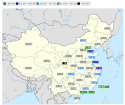We dairy farm in the Catlins which is an area within the province of Southland. The area of the Catlins is nearly twice the size of Hong Kong, however, the resident population is about 1600-2000. While the most live in small towns which get reasonable cell phone coverage,. many of us farmers live further out in more isolated settlements of just a handful of families.Our settlement is under 20 people spread out over say 12sq miles
On the farm, we do have a satellite phone and internet package but it does not work very well. I don't retain the tech specifics very well, so I think our download speed is about 20 something something and is much slower than what the best copper line connection can give. It stops working in the rain and other atmospheric conditions and with provider restrictions, our connected time, amounts to about four working days. Our copper phone line does not work very well either and spends more times a week out of order than working there is a couple of places on the farm where I can get a cell signal of about 1bar Currently I pay $80 for 7gigs of data on my cell phone data. When I want to go online I drive to this place where the signal is stronger and use my . cell phone as a hotspot for my laptop.
Because of the topography, there are many signal blackspots we need more cellphone towers to what is currently provided.
Heres a article which best describe the problems we have down here
Community demands better communications in the south Catlins
Mary-Jo Tohill15:20, Aug 06 2018
Chaslands resident Dianne Miller in a notorious black spot area of the Catlins at Samson Hill with no cellphone coverage, which is reliant on the copper landline network for essential communication, which she claims is unreliable
High above the Miller farm in the Chaslands, there is a log of wood marking a special spot.
This is where Dianne and Tony Miller can get cellphone reception when they need to, in an area of the south Catlins renowned for almost non-existent coverage and power cuts.
They have a satellite phone, but if all else fails - and the landline network does regularly - the elevated spot is where they can make contact with the outside world........
He is the Fire and Emergency New Zealand - Papatowai volunteer rural fire force controller and knows first-hand what can happen when comms go down at the station.
"If the phone line goes out, it becomes an issue."
The long stretch between Tokanui and Owaka on the Southern Scenic Route between Invercargill and Balclutha is a mobile dead zone.
The only spot along this section of State Highway 6 to have Mobile Black Spot funding dished out is Waikawa and Waikawa south, near Curio Bay.
Many people in this sparsely populated area between Papatowai and Tokanui rely on landlines for essential communication, and even then it's not the most reliable.
A Chorus spokesman said trees, weather and atmospheric conditions often blocked signals to radio towers and contributed to outages, and that the network was only designed to supply basic phone services in the remote area.
Residents are concerned the increase in tourism to the Catlins is cause for alarm without reliable communication.
Not only that, but poor coverage could impact on emergency services and response times, and a lack of cost effective technology could hinder business growth and education.
Dianne raised her concerns with Crown Infrastructure Government and Industry Affairs general manager Nick Manning during a meeting with Crown infrastructure partners recently.
"I was keen to push the point that we have a failing landline network and cannot afford to lose this very basic service as we have some elderly with health issues that rely on this service, also our local fire station.
"
This area can lose the phone for up to four days a week and not many weeks go by when it has not had a fault."
Manning said he was not mandated to comment on the situation but was able to update the community on phase two of the Rural Broadband Initiative and Mobile Black Spots fund rolling out across the country over the next four years.
Since the meeting, Manning said he had discussed the community's concerns with the ministers involved and the Rural Connectivity Group, who is responsible for installing the 4G broadband towers.
"Depending on the location and configuration of these towers, this new mobile coverage is likely to spill over onto the roads along the south coast."
The group was also finalising a tender for an additional $105 million of funding, which may result in the Catlins receiving more towers or coverage, he said.
However, Dianne said it was "not good enough" that people were having to put up with an ageing landline infrastructure in the meantime.
"While I think it's great ... [more towers are] not going to benefit everyone because of the hilly terrain."
Clutha Southland MP Hamish Walker initiated Manning's visit and said: "Internet is as essential as our roads".
"For us to attract people to the district we need to be connected to the world through broadband. It is vital that rural New Zealand has high speed, reliable internet so that locals, businesses, medical centres, schools and tourists can go about their day efficiently and effectively.
"I am also concerned that volunteer fire stations don't have good cellphone coverage in the Catlins, or the medical centre in Owaka and the surrounding areas."


